
Diuris pardina, commonly known as the leopard orchid or leopard doubletail is a species of orchid which is endemic to south-eastern Australia. It has two or three grass-like leaves and up to ten yellow flowers with reddish-brown marks and blotches.

Diuris behrii, commonly known as golden cowslips, is a species of orchid which is endemic to eastern Australia. It occurs in South Australia, Victoria, New South Wales and the Australian Capital Territory. It has between three and six grass-like leaves and a flowering stem with up to four drooping, yellow flowers with dark streaks on the labellum. The flowers appear between September and November in its native range.

Diuris protena, commonly known as northern golden moths, is a species of orchid which is endemic to Victoria. It has a tuft of between four and eight leaves at the base and up to three mostly yellow flowers with a few light-coloured marks. It is classed as "endangered" in Victoria.
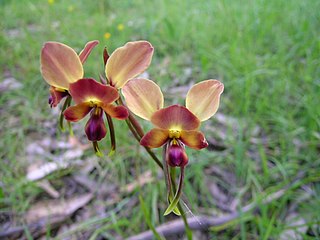
Diuris orientis, commonly called the wallflower orchid or eastern wallflower orchid, is a species of orchid which is endemic to eastern Australia. Like others in the genus Diuris, it has two ear-like petals and is similar to the common donkey orchid of Western Australia with which it has been confused. This species is found in New South Wales, Victoria, South Australia and Tasmania and its stalk-like petal "claw" is shorter in than those of D. corymbosa.

Diuris basaltica, commonly known as little golden moths, or small golden moths is a species of orchid which is endemic to Victoria. The species has suffered a catastrophic reduction in range and distribution as a result of clearing for agriculture, then by urban expansion until only about four hundred plants remain in the wild.
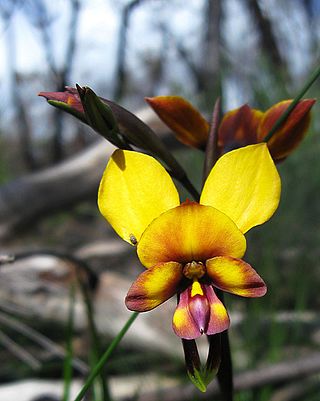
Diuris magnifica, commonly called the large pansy orchid is a species of orchid which is endemic to the south-west of Western Australia. It has large, colourful flowers and is common in a narrow range near the coast around Perth, often occurring with the similar but smaller Diuris corymbosa.
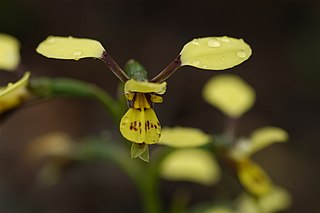
Diuris praecox, commonly known as the early doubletail, Newcastle doubletail or rough doubletail is a species of orchid which is endemic to New South Wales. It has two or three grass-like leaves and up to ten light yellow flowers with a few dark brown marks. It is threatened by urbanisation.

Diuris punctata, commonly known as the purple donkey orchid is a species of orchid which is endemic to south-eastern continental Australia. It has two grass-like leaves and up to ten purple or mauve flowers, often with darker, sometimes yellow marks. A yellow form from near Guyra is probably now extinct.
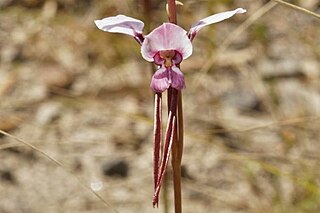
Diuris arenaria, commonly known as the Tomaree donkey orchid or sand doubletail is a species of orchid which is endemic to a very small area of New South Wales. It has two grass-like leaves and up to nine mauve or light purple and white flowers. It has a very limited distribution near Newcastle.
Diuris exitela, commonly called the Mount Moffat doubletail, is a species of orchid which is endemic to central western Queensland. It has two linear leaves at its base, up to twelve bright yellow flowers with dark brown markings and grows on sandstone cliffs and ridges.
Diuris flavescens, commonly called the pale yellow doubletail or Wingham doubletail, is a species of orchid which is endemic to a small area in New South Wales. It has two linear leaves at its base and up to five pale yellow flowers with dark brown markings. Fewer than 200 plants survive in grassy forest near Wingham.
Diuris fragrantissima, commonly called the fragrant doubletail or Sunshine diuris, is a species of orchid which is endemic to a small area to the west of Melbourne. It has two linear leaves at its base and up to twelve white flowers with mauve or pale purple markings with unusually long lateral sepals. Only about thirty plants survive in grassland near Sunshine.

Diuris gregaria, commonly known as clumping golden moths is a species of orchid that is endemic to Victoria. It between three and seven leaves and one or two bright yellow flowers with a few dark striations and usually grows in dense tufts of up to thirty plants. It is a rare species mostly only found in grassland west of Melbourne.
Diuris immaculata, commonly known as the little Esperance bee orchid, is a rare species of orchid that is endemic to the south-west of Western Australia. It has between four and six leaves and up to three golden yellow flowers without markings. It is only known from near Esperance.
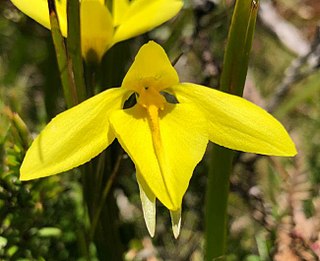
Diuris lanceolata, commonly known as large golden moths, is a species of orchid that is endemic to Tasmania. It has between two and four leaves and up to three golden to orange-yellow flowers with a few dark streaks.

Diuris monticola, commonly known as highland golden moths, is a species of orchid that is endemic to south-eastern Australia. It is a common and widespread, late flowering species growing in grassland and woodland habitats at higher altitudes. It has a tuft of up to nine leaves at the base and up to four slightly drooping bright yellow flowers with dark streaks in the centre.
Diuris ochroma, commonly known as pale goat orchid, or pale golden moths is a species of orchid that is endemic to south-eastern continental Australia. It has three or four leaves at its base and up to four slightly drooping pale yellow flowers with dark reddish purple streaks. It is an uncommon species found in two disjunct populations, in higher parts of each of New South Wales and Victoria.

Diuris pedunculata, commonly known as the small snake orchid, is a species of orchid which is endemic to New South Wales. It usually has two leaves at its base and one or two yellow and orange flowers with purple markings. It originally occurred in scattered populations between Tenterfield and the Hawkesbury River but because of habitat loss is now only known from the New England Tableland.

Diuris platichila, commonly known as the Blue Mountains doubletail, is a species of orchid that is endemic to a few isolated places in the Blue Mountains in New South Wales. It has two leaves and up to eight yellow flowers with dark markings on the dorsal sepal and labellum. It has relatively long, thin lateral sepals and the central lobe of the labellum is wedge-shaped. It forms hybrids with other species of Diuris.
Diuris striata is a poorly-known species of orchid that is endemic to New South Wales. It has a two grass-like leaves and about four mauve flowers with dark purple streaks on the labellum.














